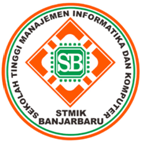Implementasi Neural Network Untuk Prediksi Penjualan Produk (Studi Kasus Penjualan Siomay)
Abstract
Abstrak. Ketepatan prediksi produksi sangat diperlukan dalam usaha penjualan produk, khususnya produk makanan yang bahan bakunya memiliki umur simpan yang pendek. Tulisan ini bertujuan menyajikan model aplikasi sistem berbasis algoritma Neural Network untuk memprediksi jumlah penjualan Siomay di masa datang, sebagai acuan mempersiapkan bahan baku dengan tepat. Prediksi menggunakan data historis sebagai data pelatihan sistem. Uji coba Neural Network menggunakan 357 data historis penjualan, 7 data awal digunakan sebagai referensi, 315 data sebagai data latih, dan 35 data terakhir sebagai data uji. Variabel masukan neural network berupa rerata penjualan 7 hari sebelumnya, nilai penjualan 1 hingga 3 hari sebelumnya, akhir bulan, identifikasi hari diskon/benefit, dan akhir pekan. Pelatihan neural network dilakukan dengan model 7-6-1, 7-7-1 dan 7-8-1 dengan laju pelatihan [0.05, 0.1, 0.5, 1, 2 dan 3]. Dari hasil pengujian menggunakan 35 data uji pada ketiga model didapatkan nilai kesalahan terkecil pada model 7-7-1 dengan Mean Square Error (MSE) 1879.8 dan tingkat akurasi prediksi sebesar 90.8%.
Kata kunci: Jaringan saraf tiruan; Data latih; Data uji; Tingkat akurasi;Â Mean Square Error
Â
Abstract. The accuracy of production predictions is very necessary in the business of selling products, especially food products whose raw materials have a short shelf life. This paper aims to present a system application model based on the Neural Network algorithm to predict the number of Siomay sales in the future, as a reference for preparing raw materials appropriately. Prediction uses historical data as system training data. The Neural Network trial uses 357 historical sales data, 7 initial data are used as references, 315 data as training data, and the last 35 data as test data. The input variables for the neural network are the average sales of the previous 7 days, the value of sales from the previous 1 to 3 days, the end of the month, identification of discount/benefit days, and weekends. Neural network training was carried out using 7-6-1, 7-7-1 and 7-8-1 models with training rates [0.05, 0.1, 0.5, 1, 2 and 3]. From the test results using 35 test data on the three models, the smallest error value is obtained in the 7-7-1 model with a Mean Square Error (MSE) of 1879.8 and a prediction accuracy rate of 90.8%.
Keywords: Artificial neural network; Training data; Test data; Accuracy level; Mean Square Error
References
R. Zudaruddin, Forecasting untuk kegiatan ekonomi dan bisnis. Samarinda: RV Pustaka Horizon, 2019.
A. Sreeram and S. Carraher, “Sales Forecast In Industries Using Artificial Neural Networks,†p. 12, 2018.
R. M. Cantón Croda, D. E. Gibaja Romero, and S. O. Caballero Morales, “Sales Prediction through Neural Networks for a Small Dataset,†IJIMAI, vol. 5, no. 4, p. 35, 2019, doi: 10.9781/ijimai.2018.04.003.
M. - and D. L. Warganegara, “Implementation of Artificial Neural Network in Forecasting Sales Volume in Tokopedia Indonesia,†IJACSA, vol. 12, no. 5, 2021, doi: 10.14569/IJACSA.2021.0120551.
M. Alborzi, “Online Sales Forecasting of E-Products of Online Store Using the Artificial Neural Network Approach and Customer Sentiment Analysis,†Science Arena Publications Specialty Journal of Knowledge Management, vol. 3, no. 1, pp. 1-6, 2018.
C. Fauzi and A. Dzulfikar, “Implementation of Product Sales Forecast Using Artificial Neural Network Method,†IJISTECH, vol. 5, no. 2, p. 153, Aug. 2021, doi: 10.30645/ijistech.v5i2.126.
B. Tiara, “Prediksi Penjualan Menggunakan Algoritma Neural Network: Studi Kasus di PT. Balaraja Food Makmur Abadi,†vol. 6, no. 1, p. 7, 2018.
S. Setti, I. A. R. Simbolon, M. Syafiq, and I. Parlina, “Penerapan Jaringan Syaraf Tiruan dalam Memprediksi Jumlah Ekspor Minyak Bumi di Indonesia,†JITE, vol. 2, no. 1, p. 31038, Jul. 2018, doi: 10.31289/jite.v2i1.1658.
J. Devillers, Neural networks in QSAR and drug design. London San Diego: Academic Press, 1996.
D. Suhartono, “Dasar Pemahaman Neural Network,†Dasar Pemahaman Neural Network, Jul. 26, 2012. https://socs.binus.ac.id/2012/07/26/konsep-neural-network/ (accessed Oct. 08, 2021).
F. Gaxiola, P. Melin, and F. Valdez, New Backpropagation Algorithm with Type-2 Fuzzy Weights for Neural Networks. Cham: Springer International Publishing, 2016. doi: 10.1007/978-3-319-34087-6.
K. Patan, Robust and Fault-Tolerant Control: Neural-Network-Based Solutions, vol. 197. Cham: Springer International Publishing, 2019. doi: 10.1007/978-3-030-11869-3.
P. Sibi, S. A. Jones, and P. Siddarth, “Analysis of Different Activation Functions Using Back Propagation Neural Networks", vol. 47, p. 5, 2013.
S. Sharma, S. Sharma, U. Scholar, and A. Athaiya, “Activation Functions In Neural Networks,†vol. 4, no. 12, p. 7, 2020.
Widodo, Sistem Neuro Fuzzy untuk Pengolahan Informasi, Pemodelan, dan Kendali. Yogyakarta: Graha Ilmu, 2005.
H. Junaedi, H. Budianto, and I. Maryati, “Data Transformation Pada Data Mining,†p. 7, 2011.
R. Rojas, “The Backpropagation Algorithm,†in Neural Networks, Berlin, Heidelberg: Springer Berlin Heidelberg, 1996, pp. 149–182. doi: 10.1007/978-3-642-61068-4_7.
M. Negnevitsky, Artificial intelligence: a guide to intelligent systems, 2nd ed. Harlow, England ; New York: Addison-Wesley, 2005.
How To Cite This :
Refbacks
- There are currently no refbacks.










